
The Research Gap (Literature Gap)
Everything you need to know to find a quality research gap
By: Ethar Al-Saraf (PhD) | Expert Reviewed By: Eunice Rautenbach (DTech) | November 2022
If you’re just starting out in research, chances are you’ve heard about the elusive research gap (also called a literature gap). In this post, we’ll explore the tricky topic of research gaps. We’ll explain what a research gap is, look at the four most common types of research gaps, and unpack how you can go about finding a suitable research gap for your dissertation, thesis or research project.
Overview: Research Gap 101
- What is a research gap
- Four common types of research gaps
- Practical examples
- How to find research gaps
- Recap & key takeaways
What (exactly) is a research gap?
Well, at the simplest level, a research gap is essentially an unanswered question or unresolved problem in a field, which reflects a lack of existing research in that space. Alternatively, a research gap can also exist when there’s already a fair deal of existing research, but where the findings of the studies pull in different directions , making it difficult to draw firm conclusions.
For example, let’s say your research aims to identify the cause (or causes) of a particular disease. Upon reviewing the literature, you may find that there’s a body of research that points toward cigarette smoking as a key factor – but at the same time, a large body of research that finds no link between smoking and the disease. In that case, you may have something of a research gap that warrants further investigation.
Now that we’ve defined what a research gap is – an unanswered question or unresolved problem – let’s look at a few different types of research gaps.
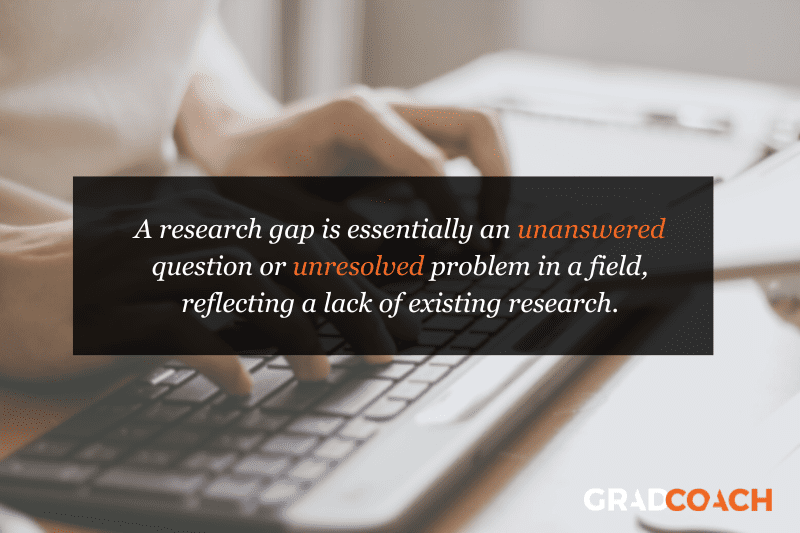
Types of research gaps
While there are many different types of research gaps, the four most common ones we encounter when helping students at Grad Coach are as follows:
- The classic literature gap
- The disagreement gap
- The contextual gap, and
- The methodological gap
Need a helping hand?
1. The Classic Literature Gap
First up is the classic literature gap. This type of research gap emerges when there’s a new concept or phenomenon that hasn’t been studied much, or at all. For example, when a social media platform is launched, there’s an opportunity to explore its impacts on users, how it could be leveraged for marketing, its impact on society, and so on. The same applies for new technologies, new modes of communication, transportation, etc.
Classic literature gaps can present exciting research opportunities , but a drawback you need to be aware of is that with this type of research gap, you’ll be exploring completely new territory . This means you’ll have to draw on adjacent literature (that is, research in adjacent fields) to build your literature review, as there naturally won’t be very many existing studies that directly relate to the topic. While this is manageable, it can be challenging for first-time researchers, so be careful not to bite off more than you can chew.

2. The Disagreement Gap
As the name suggests, the disagreement gap emerges when there are contrasting or contradictory findings in the existing research regarding a specific research question (or set of questions). The hypothetical example we looked at earlier regarding the causes of a disease reflects a disagreement gap.
Importantly, for this type of research gap, there needs to be a relatively balanced set of opposing findings . In other words, a situation where 95% of studies find one result and 5% find the opposite result wouldn’t quite constitute a disagreement in the literature. Of course, it’s hard to quantify exactly how much weight to give to each study, but you’ll need to at least show that the opposing findings aren’t simply a corner-case anomaly .

3. The Contextual Gap
The third type of research gap is the contextual gap. Simply put, a contextual gap exists when there’s already a decent body of existing research on a particular topic, but an absence of research in specific contexts .
For example, there could be a lack of research on:
- A specific population – perhaps a certain age group, gender or ethnicity
- A geographic area – for example, a city, country or region
- A certain time period – perhaps the bulk of the studies took place many years or even decades ago and the landscape has changed.
The contextual gap is a popular option for dissertations and theses, especially for first-time researchers, as it allows you to develop your research on a solid foundation of existing literature and potentially even use existing survey measures.
Importantly, if you’re gonna go this route, you need to ensure that there’s a plausible reason why you’d expect potential differences in the specific context you choose. If there’s no reason to expect different results between existing and new contexts, the research gap wouldn’t be well justified. So, make sure that you can clearly articulate why your chosen context is “different” from existing studies and why that might reasonably result in different findings.

4. The Methodological Gap
Last but not least, we have the methodological gap. As the name suggests, this type of research gap emerges as a result of the research methodology or design of existing studies. With this approach, you’d argue that the methodology of existing studies is lacking in some way , or that they’re missing a certain perspective.
For example, you might argue that the bulk of the existing research has taken a quantitative approach, and therefore there is a lack of rich insight and texture that a qualitative study could provide. Similarly, you might argue that existing studies have primarily taken a cross-sectional approach , and as a result, have only provided a snapshot view of the situation – whereas a longitudinal approach could help uncover how constructs or variables have evolved over time.

Practical Examples
Let’s take a look at some practical examples so that you can see how research gaps are typically expressed in written form. Keep in mind that these are just examples – not actual current gaps (we’ll show you how to find these a little later!).
Context: Healthcare
Despite extensive research on diabetes management, there’s a research gap in terms of understanding the effectiveness of digital health interventions in rural populations (compared to urban ones) within Eastern Europe.
Context: Environmental Science
While a wealth of research exists regarding plastic pollution in oceans, there is significantly less understanding of microplastic accumulation in freshwater ecosystems like rivers and lakes, particularly within Southern Africa.
Context: Education
While empirical research surrounding online learning has grown over the past five years, there remains a lack of comprehensive studies regarding the effectiveness of online learning for students with special educational needs.
As you can see in each of these examples, the author begins by clearly acknowledging the existing research and then proceeds to explain where the current area of lack (i.e., the research gap) exists.

How To Find A Research Gap
Now that you’ve got a clearer picture of the different types of research gaps, the next question is of course, “how do you find these research gaps?” .
Well, we cover the process of how to find original, high-value research gaps in a separate post . But, for now, I’ll share a basic two-step strategy here to help you find potential research gaps.
As a starting point, you should find as many literature reviews, systematic reviews and meta-analyses as you can, covering your area of interest. Additionally, you should dig into the most recent journal articles to wrap your head around the current state of knowledge. It’s also a good idea to look at recent dissertations and theses (especially doctoral-level ones). Dissertation databases such as ProQuest, EBSCO and Open Access are a goldmine for this sort of thing. Importantly, make sure that you’re looking at recent resources (ideally those published in the last year or two), or the gaps you find might have already been plugged by other researchers.
Once you’ve gathered a meaty collection of resources, the section that you really want to focus on is the one titled “ further research opportunities ” or “further research is needed”. In this section, the researchers will explicitly state where more studies are required – in other words, where potential research gaps may exist. You can also look at the “ limitations ” section of the studies, as this will often spur ideas for methodology-based research gaps.
By following this process, you’ll orient yourself with the current state of research , which will lay the foundation for you to identify potential research gaps. You can then start drawing up a shortlist of ideas and evaluating them as candidate topics . But remember, make sure you’re looking at recent articles – there’s no use going down a rabbit hole only to find that someone’s already filled the gap 🙂
Let’s Recap
We’ve covered a lot of ground in this post. Here are the key takeaways:
- A research gap is an unanswered question or unresolved problem in a field, which reflects a lack of existing research in that space.
- The four most common types of research gaps are the classic literature gap, the disagreement gap, the contextual gap and the methodological gap.
- To find potential research gaps, start by reviewing recent journal articles in your area of interest, paying particular attention to the FRIN section .
If you’re keen to learn more about research gaps and research topic ideation in general, be sure to check out the rest of the Grad Coach Blog . Alternatively, if you’re looking for 1-on-1 support with your dissertation, thesis or research project, be sure to check out our private coaching service .

Psst… there’s more (for free)
This post is part of our dissertation mini-course, which covers everything you need to get started with your dissertation, thesis or research project.
You Might Also Like:

29 Comments
This post is REALLY more than useful, Thank you very very much
Very helpful specialy, for those who are new for writing a research! So thank you very much!!
I found it very helpful article. Thank you.
Just at the time when I needed it, really helpful.
Very helpful and well-explained. Thank you
VERY HELPFUL
We’re very grateful for your guidance, indeed we have been learning a lot from you , so thank you abundantly once again.
hello brother could you explain to me this question explain the gaps that researchers are coming up with ?
Am just starting to write my research paper. your publication is very helpful. Thanks so much
How to cite the author of this?
your explanation very help me for research paper. thank you
Very important presentation. Thanks.
Best Ideas. Thank you.
I found it’s an excellent blog to get more insights about the Research Gap. I appreciate it!
Kindly explain to me how to generate good research objectives.
This is very helpful, thank you
Very helpful, thank you.
Thanks a lot for this great insight!
This is really helpful indeed!
This article is really helpfull in discussing how will we be able to define better a research problem of our interest. Thanks so much.
Reading this just in good time as i prepare the proposal for my PhD topic defense.
Very helpful Thanks a lot.
Thank you very much
This was very timely. Kudos
Great one! Thank you all.
Thank you very much.
This is so enlightening. Disagreement gap. Thanks for the insight.
How do I Cite this document please?
Submit a Comment Cancel reply
Your email address will not be published. Required fields are marked *
Save my name, email, and website in this browser for the next time I comment.
- Print Friendly
- Privacy Policy
Buy Me a Coffee

Home » Research Gap – Types, Examples and How to Identify
Research Gap – Types, Examples and How to Identify
Table of Contents

Research Gap
Definition:
Research gap refers to an area or topic within a field of study that has not yet been extensively researched or is yet to be explored. It is a question, problem or issue that has not been addressed or resolved by previous research.
How to Identify Research Gap
Identifying a research gap is an essential step in conducting research that adds value and contributes to the existing body of knowledge. Research gap requires critical thinking, creativity, and a thorough understanding of the existing literature . It is an iterative process that may require revisiting and refining your research questions and ideas multiple times.
Here are some steps that can help you identify a research gap:
- Review existing literature: Conduct a thorough review of the existing literature in your research area. This will help you identify what has already been studied and what gaps still exist.
- Identify a research problem: Identify a specific research problem or question that you want to address.
- Analyze existing research: Analyze the existing research related to your research problem. This will help you identify areas that have not been studied, inconsistencies in the findings, or limitations of the previous research.
- Brainstorm potential research ideas : Based on your analysis, brainstorm potential research ideas that address the identified gaps.
- Consult with experts: Consult with experts in your research area to get their opinions on potential research ideas and to identify any additional gaps that you may have missed.
- Refine research questions: Refine your research questions and hypotheses based on the identified gaps and potential research ideas.
- Develop a research proposal: Develop a research proposal that outlines your research questions, objectives, and methods to address the identified research gap.
Types of Research Gap
There are different types of research gaps that can be identified, and each type is associated with a specific situation or problem. Here are the main types of research gaps and their explanations:
Theoretical Gap
This type of research gap refers to a lack of theoretical understanding or knowledge in a particular area. It can occur when there is a discrepancy between existing theories and empirical evidence or when there is no theory that can explain a particular phenomenon. Identifying theoretical gaps can lead to the development of new theories or the refinement of existing ones.
Empirical Gap
An empirical gap occurs when there is a lack of empirical evidence or data in a particular area. It can happen when there is a lack of research on a specific topic or when existing research is inadequate or inconclusive. Identifying empirical gaps can lead to the development of new research studies to collect data or the refinement of existing research methods to improve the quality of data collected.
Methodological Gap
This type of research gap refers to a lack of appropriate research methods or techniques to answer a research question. It can occur when existing methods are inadequate, outdated, or inappropriate for the research question. Identifying methodological gaps can lead to the development of new research methods or the modification of existing ones to better address the research question.
Practical Gap
A practical gap occurs when there is a lack of practical applications or implementation of research findings. It can occur when research findings are not implemented due to financial, political, or social constraints. Identifying practical gaps can lead to the development of strategies for the effective implementation of research findings in practice.
Knowledge Gap
This type of research gap occurs when there is a lack of knowledge or information on a particular topic. It can happen when a new area of research is emerging, or when research is conducted in a different context or population. Identifying knowledge gaps can lead to the development of new research studies or the extension of existing research to fill the gap.
Examples of Research Gap
Here are some examples of research gaps that researchers might identify:
- Theoretical Gap Example : In the field of psychology, there might be a theoretical gap related to the lack of understanding of the relationship between social media use and mental health. Although there is existing research on the topic, there might be a lack of consensus on the mechanisms that link social media use to mental health outcomes.
- Empirical Gap Example : In the field of environmental science, there might be an empirical gap related to the lack of data on the long-term effects of climate change on biodiversity in specific regions. Although there might be some studies on the topic, there might be a lack of data on the long-term effects of climate change on specific species or ecosystems.
- Methodological Gap Example : In the field of education, there might be a methodological gap related to the lack of appropriate research methods to assess the impact of online learning on student outcomes. Although there might be some studies on the topic, existing research methods might not be appropriate to assess the complex relationships between online learning and student outcomes.
- Practical Gap Example: In the field of healthcare, there might be a practical gap related to the lack of effective strategies to implement evidence-based practices in clinical settings. Although there might be existing research on the effectiveness of certain practices, they might not be implemented in practice due to various barriers, such as financial constraints or lack of resources.
- Knowledge Gap Example: In the field of anthropology, there might be a knowledge gap related to the lack of understanding of the cultural practices of indigenous communities in certain regions. Although there might be some research on the topic, there might be a lack of knowledge about specific cultural practices or beliefs that are unique to those communities.
Examples of Research Gap In Literature Review, Thesis, and Research Paper might be:
- Literature review : A literature review on the topic of machine learning and healthcare might identify a research gap in the lack of studies that investigate the use of machine learning for early detection of rare diseases.
- Thesis : A thesis on the topic of cybersecurity might identify a research gap in the lack of studies that investigate the effectiveness of artificial intelligence in detecting and preventing cyber attacks.
- Research paper : A research paper on the topic of natural language processing might identify a research gap in the lack of studies that investigate the use of natural language processing techniques for sentiment analysis in non-English languages.
How to Write Research Gap
By following these steps, you can effectively write about research gaps in your paper and clearly articulate the contribution that your study will make to the existing body of knowledge.
Here are some steps to follow when writing about research gaps in your paper:
- Identify the research question : Before writing about research gaps, you need to identify your research question or problem. This will help you to understand the scope of your research and identify areas where additional research is needed.
- Review the literature: Conduct a thorough review of the literature related to your research question. This will help you to identify the current state of knowledge in the field and the gaps that exist.
- Identify the research gap: Based on your review of the literature, identify the specific research gap that your study will address. This could be a theoretical, empirical, methodological, practical, or knowledge gap.
- Provide evidence: Provide evidence to support your claim that the research gap exists. This could include a summary of the existing literature, a discussion of the limitations of previous studies, or an analysis of the current state of knowledge in the field.
- Explain the importance: Explain why it is important to fill the research gap. This could include a discussion of the potential implications of filling the gap, the significance of the research for the field, or the potential benefits to society.
- State your research objectives: State your research objectives, which should be aligned with the research gap you have identified. This will help you to clearly articulate the purpose of your study and how it will address the research gap.
Importance of Research Gap
The importance of research gaps can be summarized as follows:
- Advancing knowledge: Identifying research gaps is crucial for advancing knowledge in a particular field. By identifying areas where additional research is needed, researchers can fill gaps in the existing body of knowledge and contribute to the development of new theories and practices.
- Guiding research: Research gaps can guide researchers in designing studies that fill those gaps. By identifying research gaps, researchers can develop research questions and objectives that are aligned with the needs of the field and contribute to the development of new knowledge.
- Enhancing research quality: By identifying research gaps, researchers can avoid duplicating previous research and instead focus on developing innovative research that fills gaps in the existing body of knowledge. This can lead to more impactful research and higher-quality research outputs.
- Informing policy and practice: Research gaps can inform policy and practice by highlighting areas where additional research is needed to inform decision-making. By filling research gaps, researchers can provide evidence-based recommendations that have the potential to improve policy and practice in a particular field.
Applications of Research Gap
Here are some potential applications of research gap:
- Informing research priorities: Research gaps can help guide research funding agencies and researchers to prioritize research areas that require more attention and resources.
- Identifying practical implications: Identifying gaps in knowledge can help identify practical applications of research that are still unexplored or underdeveloped.
- Stimulating innovation: Research gaps can encourage innovation and the development of new approaches or methodologies to address unexplored areas.
- Improving policy-making: Research gaps can inform policy-making decisions by highlighting areas where more research is needed to make informed policy decisions.
- Enhancing academic discourse: Research gaps can lead to new and constructive debates and discussions within academic communities, leading to more robust and comprehensive research.
Advantages of Research Gap
Here are some of the advantages of research gap:
- Identifies new research opportunities: Identifying research gaps can help researchers identify areas that require further exploration, which can lead to new research opportunities.
- Improves the quality of research: By identifying gaps in current research, researchers can focus their efforts on addressing unanswered questions, which can improve the overall quality of research.
- Enhances the relevance of research: Research that addresses existing gaps can have significant implications for the development of theories, policies, and practices, and can therefore increase the relevance and impact of research.
- Helps avoid duplication of effort: Identifying existing research can help researchers avoid duplicating efforts, saving time and resources.
- Helps to refine research questions: Research gaps can help researchers refine their research questions, making them more focused and relevant to the needs of the field.
- Promotes collaboration: By identifying areas of research that require further investigation, researchers can collaborate with others to conduct research that addresses these gaps, which can lead to more comprehensive and impactful research outcomes.
Disadvantages of Research Gap
While research gaps can be advantageous, there are also some potential disadvantages that should be considered:
- Difficulty in identifying gaps: Identifying gaps in existing research can be challenging, particularly in fields where there is a large volume of research or where research findings are scattered across different disciplines.
- Lack of funding: Addressing research gaps may require significant resources, and researchers may struggle to secure funding for their work if it is perceived as too risky or uncertain.
- Time-consuming: Conducting research to address gaps can be time-consuming, particularly if the research involves collecting new data or developing new methods.
- Risk of oversimplification: Addressing research gaps may require researchers to simplify complex problems, which can lead to oversimplification and a failure to capture the complexity of the issues.
- Bias : Identifying research gaps can be influenced by researchers’ personal biases or perspectives, which can lead to a skewed understanding of the field.
- Potential for disagreement: Identifying research gaps can be subjective, and different researchers may have different views on what constitutes a gap in the field, leading to disagreements and debate.
About the author
Muhammad Hassan
Researcher, Academic Writer, Web developer
You may also like

Data Collection – Methods Types and Examples

Delimitations in Research – Types, Examples and...

Research Process – Steps, Examples and Tips

Research Design – Types, Methods and Examples

Institutional Review Board – Application Sample...

Evaluating Research – Process, Examples and...
Understanding the skills gap—and what employers can do about it
Subscribe to the center for technology innovation newsletter, elizabeth mann levesque elizabeth mann levesque former brookings expert, student support & classroom climate consultant - university of michigan @elizkmann.
December 6, 2019
This is the first section of “ Employer Perspectives on Workforce Development ,” a series that chronicles how business leaders are adapting to the future of work.
The nature of work is rapidly changing due to emerging technologies and disruptive forces, such as artificial intelligence , the gig economy , and automation . The exact effect of these and other changes remain unknown, but one thing seems certain: The skills that employers value and rely upon are changing. In turn, a “skills gap” has developed in which employers struggle to hire appropriately trained workers. A recent Deloitte report illustrates the breadth of this problem in the context of manufacturing alone: “[T]he skills gap may leave an estimated 2.4 million positions unfilled between 2018 and 2028, with a potential economic impact of $2.5 trillion.”
The skills gap poses a pressing policy problem, and employers are among those on the frontlines of this battle. In this context, it is important to understand employer perspectives on hiring, training, and retraining a skilled workforce. Through interviews with four different manufacturing employers—ranging in size from under 1,000 employees to over 41,000 employees—this “ Employer Perspectives on Workforce Development ” series offers a window into the challenges that employers are encountering as well as the innovative solutions they are pursuing with respect to workforce development in an era of rapid technological change. Each interview explores questions such as:
- How are technological changes shaping your workforce needs?
- What challenges have you encountered with respect to recruiting, training, and retaining appropriately educated and skilled employees?
- What kind of success have you had in terms of workforce development, and what factors have been important to this success?
Several caveats are in order before proceeding. First, this series is not meant to provide a representative or comprehensive overview of the “employer perspective” in the U.S. In addition, employer perspectives are just one dimension we should consider when addressing workforce development challenges. Nonetheless, employers play an important role in identifying challenges and subsequently creating, piloting, and refining innovative solutions. Engaging in this process may in fact be a matter of survival, given the large-scale changes that are reshaping the workforce environment. As such, exploring how employers experience and respond to these challenges is a valuable part of the larger conversation on workforce development.
The role of employers in addressing the skills gap
To contextualize the posts in this series, each of which focuses on a particular employer’s experience, it is worth beginning with a discussion of the skills gap and some of the challenges that employers face in addressing this gap and related issues. The term “skills gap” describes a fundamental mismatch between the skills that employers rely upon in their employees, and the skills that job seekers possess. This mismatch makes it difficult for individuals to find jobs and for employers to find appropriately trained workers.
Related Content
Elizabeth Mann Levesque
October 18, 2018
Employer leadership is a key part of addressing this mismatch. Writing for the Harvard Business School series “Managing the Future of Work,” Joseph Fuller argues that “[b]usiness leaders must champion an employer-led skills-development system, in which they bring the type of rigor and discipline to sourcing middle-skills talent that they historically applied to their materials supply chains.” One example of a strategy that focuses on employer leadership is the U.S. Chamber of Commerce Foundation’s Talent Pipeline Management (TPM) Initiative, which “shifts employers into the driver’s seat to proactively lead partnerships with talent providers.”
While employer leadership is important, creating robust talent pipelines also requires cross-sector collaboration. Indeed, experts that argue for employer and state leadership alike emphasize the importance of collaboration between government, education, and business. For example, Fuller focuses on business leadership while highlighting “the need for leaders from the business, education, and political spheres to act in concert.” A recent report from the Georgetown Center on Education and the Workforce that focuses on state leadership in creating career pathways makes a similar argument regarding collaboration across these sectors. Referencing recommendations from the International Economic Development Council, the authors argue that “strong alliances” between economic developers, postsecondary institutions, and businesses “can together better address the mismatch between jobs and workers.” Keeping in mind the importance of this collaboration, this series focuses primarily on employers’ efforts to develop and maintain a healthy workforce.
Challenges in addressing the skills gap
For many employers, taking on a leadership role in workforce development will require changes to prior practice. Fundamentally, employers must identify and signal the skills they need, as well as develop mechanisms to recruit, train, and retain employees. However, many employers are not prepared to do so. Underscoring this point, Fuller argues that employers must “radically rethink their businesses’ roles in nurturing talent.”
“Fundamentally, employers must identify and signal the skills they need, as well as develop mechanisms to recruit, train, and retain employees.”
A recent report from The Brookings Institution and The National Center for the Middle Market helps to illustrate the types of changes that employers should consider. Focusing on middle market companies with annual revenues between $10 million and $1 billion, the authors identify common practices that hinder employers’ abilities to develop talent pipelines. The challenges and solutions identified in this context are likely broadly applicable, as companies of all sizes contend with the skills gap and the rapid pace of change in the nature of work.
The authors find that many middle market companies are not equipped to recruit, hire, train, and retain a skilled workforce. Among other factors, they draw attention to the role of HR departments. Strategic, forward-looking recruitment and hiring are important elements of developing a skilled workforce, but in 44% of middle market firms, HR departments are primarily operational rather than strategic. The authors describe how “lean HR teams” lack the time and resources necessary to focus on strategic recruitment. Perhaps as a result, many middle market firms lack a clear process for recruiting new employees; 59% wait until there is a specific position to be filled rather than drawing upon ongoing outreach efforts.
Related Books
Darrell M. West
October 15, 2019
In addition, the report describes how a lack of systematic, internal training programs can make it difficult to develop talent internally. Many firms thus find it difficult to create a “deeper bench”–while 55% of middle market firms have an ongoing training system, 45% do not. In addition, 61% of middle market firms do not have systems in place for internal career advancement. And only 30% of firms partner with educational or training organizations, “despite the fact that such partnerships could help companies bolster the capabilities of their internal HR staff.” In short, the authors identify a number of limitations with respect to employers’ capacity to hire, train, and retain skilled workers.
The authors also identify a number of proactive steps middle market employers can take to address these shortcomings and, in doing so, create more robust talent pipelines. These strategies include investing in talent planning through strategic HR initiatives, developing internal career ladders and internship programs, and building partnerships with educational institutions and others, such as local chambers of commerce and business associations and trade groups.
Windows into employers’ experiences
As the preceding discussion illustrates, there is a healthy and growing body of research on the challenges and potential solutions related to the skills gap. This series seeks to provide additional, on-the-ground insight into how employers encounter and address these challenges. Further, this series situates each employer’s experience in research and recommendations related to the skills gap and workforce development more broadly. The series concludes with a post that reflects on the insights shared by employers, identifying themes, promising solutions, and potential next steps for policymakers.
Read the next section of “Employer Perspectives on Workforce Development,” or visit the series homepage .
The Brookings Institution is a nonprofit organization devoted to independent research and policy solutions. Its mission is to conduct high-quality, independent research and, based on that research, to provide innovative, practical recommendations for policymakers and the public. The conclusions and recommendations of any Brookings publication are solely those of its author(s), and do not reflect the views of the Institution, its management, or its other scholars.
Workforce Development
Governance Studies
Center for Technology Innovation
Hannah C. Kistler, Shaun M. Dougherty
April 9, 2024
Martha Ross, Mark Muro
January 4, 2024
Mark Muro, Yang You
December 12, 2023
- Link to facebook
- Link to linkedin
- Link to twitter
- Link to youtube
- Writing Tips
How to Identify a Research Gap
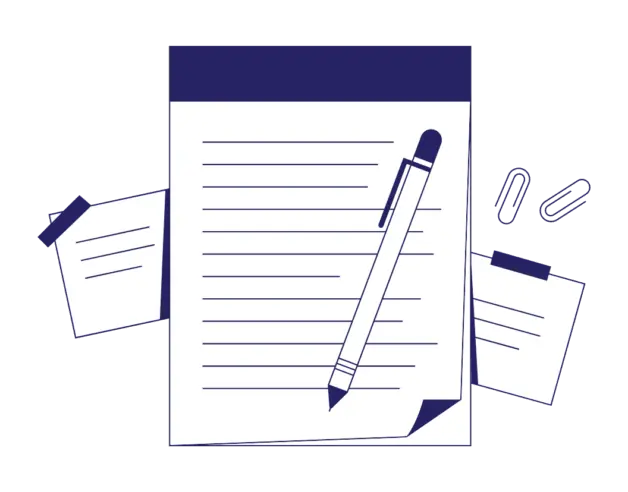
- 5-minute read
- 10th January 2024
If you’ve been tasked with producing a thesis or dissertation, one of your first steps will be identifying a research gap. Although finding a research gap may sound daunting, don’t fret! In this post, we will define a research gap, discuss its importance, and offer a step-by-step guide that will provide you with the essential know-how to complete this critical step and move on to the rest of your research project.
What Is a Research Gap?
Simply put, a research gap is an area that hasn’t been explored in the existing literature. This could be an unexplored population, an untested method, or a condition that hasn’t been investigated yet.
Why Is Identifying a Research Gap Important?
Identifying a research gap is a foundational step in the research process. It ensures that your research is significant and has the ability to advance knowledge within a specific area. It also helps you align your work with the current needs and challenges of your field. Identifying a research gap has many potential benefits.
1. Avoid Redundancy in Your Research
Understanding the existing literature helps researchers avoid duplication. This means you can steer clear of topics that have already been extensively studied. This ensures your work is novel and contributes something new to the field.
2. Guide the Research Design
Identifying a research gap helps shape your research design and questions. You can tailor your studies to specifically address the identified gap. This ensures that your work directly contributes to filling the void in knowledge.
3. Practical Applications
Research that addresses a gap is more likely to have practical applications and contributions. Whether in academia, industry, or policymaking, research that fills a gap in knowledge is often more applicable and can inform decision-making and practices in real-world contexts.
4. Field Advancements
Addressing a research gap can lead to advancements in the field . It may result in the development of new theories, methodologies, or technologies that push the boundaries of current understanding.
5. Strategic Research Planning
Identifying a research gap is crucial for strategic planning . It helps researchers and institutions prioritize areas that need attention so they can allocate resources effectively. This ensures that efforts are directed toward the most critical gaps in knowledge.
6. Academic and Professional Recognition
Researchers who successfully address significant research gaps often receive peer recognition within their academic and professional communities. This recognition can lead to opportunities for collaboration, funding, and career advancement.
How Do I Identify a Research Gap?
1. clearly define your research topic .
Begin by clearly defining your research topic. A well-scoped topic serves as the foundation for your studies. Make sure it’s not too broad or too narrow; striking the right balance will make it easier to identify gaps in existing literature.
Find this useful?
Subscribe to our newsletter and get writing tips from our editors straight to your inbox.
2. Conduct a Thorough Literature Review
A comprehensive literature review is a vital step in any research. Dive deep into the existing research related to your topic. Look for patterns, recurring themes, and consensus among scholars. Pay attention to areas where conflicting opinions or gaps in understanding emerge.
3. Evaluate Existing Studies
Critically evaluate the studies you encounter during your literature review. Assess the paradigms , methodologies, findings, and limitations of each. Note any discrepancies, unanswered questions, or areas where further investigation is warranted. These are potential indicators of research gaps.
4. Identify Unexplored Perspectives
Consider the perspectives presented in the existing literature. Are there alternative viewpoints or marginalized voices that haven’t been adequately explored? Identifying and incorporating diverse perspectives can often lead to uncharted territory and help you pinpoint a unique research gap.
Additional Tips
Stay up to date with emerging trends.
The field of research is dynamic, with new developments and emerging trends constantly shaping the landscape. Stay up to date with the latest publications, conferences, and discussions in your field and make sure to regularly check relevant academic search engines . Often, identifying a research gap involves being at the forefront of current debates and discussions.
Seek Guidance From Experts
Don’t hesitate to reach out to experts in your field for guidance. Attend conferences, workshops, or seminars where you can interact with seasoned researchers. Their insights and experience can provide valuable perspectives on potential research gaps that you may have overlooked. You can also seek advice from your academic advisor .
Use Research Tools and Analytics
Leverage tech tools to analyze patterns and trends in the existing literature. Tools like citation analysis, keyword mapping, and data visualization can help you identify gaps and areas with limited exploration.
Identifying a research gap is a skill that evolves with experience and dedication. By defining your research topic, meticulously navigating the existing literature, critically evaluating studies, and recognizing unexplored perspectives, you’ll be on your way to identifying a research gap that will serve as the foundation for your paper, thesis, or dissertation topic .
If you need any help with proofreading your research paper , we can help with our research paper editing services . You can even try a sample of our services for free . Good luck with all your research!
Share this article:
Post A New Comment
Got content that needs a quick turnaround? Let us polish your work. Explore our editorial business services.
3-minute read
What Is a Content Editor?
Are you interested in learning more about the role of a content editor and the...
4-minute read
The Benefits of Using an Online Proofreading Service
Proofreading is important to ensure your writing is clear and concise for your readers. Whether...
2-minute read
6 Online AI Presentation Maker Tools
Creating presentations can be time-consuming and frustrating. Trying to construct a visually appealing and informative...
What Is Market Research?
No matter your industry, conducting market research helps you keep up to date with shifting...
8 Press Release Distribution Services for Your Business
In a world where you need to stand out, press releases are key to being...
How to Get a Patent
In the United States, the US Patent and Trademarks Office issues patents. In the United...

Make sure your writing is the best it can be with our expert English proofreading and editing.

Beyond hiring: How companies are reskilling to address talent gaps
As technologies and business models continue their rapid evolution, companies are experiencing a step change in the workforce skills they need to thrive and grow. Previous research has shown that as many as 375 million workers globally might have to change occupations in the next decade to meet companies’ needs and that automation could free employees to spend as much as 30 percent of their time on new work. 1 “ Jobs lost, jobs gained: What the future of work will mean for jobs, skills, and wages ,” McKinsey Global Institute, November 2017. Now, in a new McKinsey Global Survey on future workforce needs, nearly nine in ten executives and managers say their organizations either face skill gaps already or expect gaps to develop within the next five years. 2 The online survey was in the field from May 14 to May 24, 2019, and garnered responses from 1,216 participants representing the full range of regions, industries, company sizes, functional specialties, and tenures.
Although most respondents say their organizations consider it a priority to address skill shortages, few say their organizations understand how to equip themselves with the workforce skills they will need most. In fact, only one-third of respondents say their companies are prepared to cope with the workforce disruptions resulting from technology and market trends. Most respondents say their organizations are hiring employees in an attempt to prepare for potential skill gaps, and some have made efforts to build skills in their workforces: about one-third of respondents say their organizations have begun reskilling efforts. 3 We define “reskilling” as a programmatic effort that supports employees in building new skills so they can adapt to the fundamentally changing requirements of their roles or move into new roles. Among them, many report early progress and provide insights into what these programs look like.
Skill gaps have appeared, and companies are trying to close them
The findings from our survey suggest that companies lack the talent they will need in the future: 44 percent of respondents say their organizations will face skill gaps within the next five years, and another 43 percent report existing skill gaps (Exhibit 1). In other words, 87 percent say they either are experiencing gaps now or expect them within a few years.
Respondents expect market and technology trends to play a big part in these shifts. Three in ten say at least one-quarter of their organization’s roles are at risk of disruption in the next five years by these trends . Looking at respondents by industry, those in financial services and in high tech and telecom are the most likely to expect this level of disruption, while those in healthcare services and pharmaceutical and medical products are the least likely. (Explore the results by industry in “ An interactive look at skill gaps and reskilling efforts .”)
Respondents see a need for their organizations to address potential skill gaps in a wide range of business areas. When asked where the greatest need exists, they most often say data analytics, followed by IT management and executive management (Exhibit 2). Similarly, when looking at the specific skills with the greatest mismatch between current supply and what will be necessary in the next five years, respondents expecting skill gaps to open during that time most often identify advanced data-analysis and mathematical skills.
Nearly all respondents classify closing potential skill gaps as a priority for their organizations, and about one-third say it is among the top three priorities. However, relatively few indicate that their organizations are ready to respond. One-third say their organizations are prepared to address potential role disruptions, and a smaller share—28 percent—say their organizations make effective decisions on how to close skill gaps. A potential hurdle to effective decision making is a lack of visibility into the skills of the existing workforce and the effects that the disruptions will have on workers’ roles. Fewer than half of respondents say their organizations have a clear sense of their current skills, and just 41 percent report that organizations have a clear understanding of the roles that are likely to be disrupted.
Nevertheless, most organizations are taking steps to address their talent needs, often through a mix of actions such as hiring contract or freelance workers and redeploying employees into new roles. 4 The survey asked respondents whether their organizations are hiring (acquiring external talent through hiring or acquisition of other companies), building skills, contracting (engaging freelancers or contractors), redeploying (shifting employees to new roles in the organization), and releasing (separating individuals from the organization). The survey suggests that the most common tactic for addressing skill gaps over the past five years has been hiring, cited by two-thirds of respondents. The second-most common tactic, cited by 56 percent of respondents, is skill building, as accomplished through reskilling programs and other efforts. On average, respondents say their organizations take at least two actions to close potential gaps.
While hiring is the most commonly reported tactic in all regions, the use of other measures to match skills to needs varies by region (Exhibit 3). Respondents in Europe are more likely than those in North America to say their organizations are building skills in their workforces, whereas respondents in North America are more likely than their peers in Europe to report that their organizations have released individuals. While respondents in developed Asia–Pacific are less likely than those elsewhere to say their organizations are prioritizing skill building, those in India are the most likely to report skill-building activities at their organizations.
Respondents whose organizations are building employees’ skills are more likely to say their organizations are prepared to address role disruptions than are respondents whose organizations address gaps through other methods. Of the respondents from organizations working to build skills, 44 percent say they are prepared, compared with 19 percent of those at organizations taking other actions.
Looking ahead, respondents are much more likely to cite skill building, rather than hiring, as the most effective way to close skill gaps in the next five years. 5 Similarly, a 2017 survey found that executives at companies in Europe with more than $100 million in annual revenue were more likely to say addressing skill gaps would require retraining than to say it would require hiring. For more, see “ Retraining and reskilling workers in the age of automation ,” McKinsey Global Institute, January 2018. Half of those who expect skill gaps in the years ahead say skill building will be the most effective action for their organizations to take, whereas 31 percent cite hiring as most effective.
The who, what, and why of reskilling programs
To address talent needs, more than one-third of respondents say their organizations either have reskilled at least one group or have a pilot or a program to do so currently under way. Another one-third say their organizations have plans to launch reskilling efforts. The most commonly cited purpose of these efforts (57 percent of respondents) is to enable the implementation of a new offering, business model, or strategy. The second-most cited reason (53 percent of respondents) is reacting to emerging technological disruptions.
Half of those who expect skill gaps in the years ahead say skill building will be the most effective action for their organizations to take, whereas 31 percent cite hiring as most effective.
Among industries, respondents in high tech and telecommunications are the most likely to say their organizations have already reskilled part of their workforce: 23 percent say their companies have reskilled at least one group or class, compared with 13 percent of respondents in other industries. (For a look at the data by industry and region, see “ An interactive look at skill gaps and how organizations tackle them .”)
According to respondents, reskilling programs most often focus on building employees’ skills in critical thinking and decision making, leadership and managing others, and advanced data analysis (Exhibit 4). All are skill types that previous research has found will be in greater demand in coming years. These programs also tend to focus on building multiple skills: on average, respondents at organizations with reskilling programs say those efforts have prioritized five skills.
While a majority of respondents at organizations with current or planned reskilling programs are confident in their organization’s abilities to choose employees to train and skills to teach, most say their organizations lack the capabilities for designing other aspects of the programs. Nearly six in ten say their organizations are good at selecting which employees to reskill and have effectively prioritized the skills to address. But fewer than half say their companies have strong capabilities in curriculum design, and only one-quarter say their organizations designed the programs’ incentives well. Four in ten say designing the programs’ communications plans is a strength for their organizations, and fewer than one-quarter say the same about plans to engage external stakeholders.
Reskilling programs face other obstacles, too. Among respondents reporting current or planned reskilling programs, 53 percent say the most significant challenge has been balancing their programs’ needs with those of current business operations. Measuring the programs’ business impact is another common challenge, cited by 41 percent of respondents.

McKinsey’s original survey research
Despite these challenges, respondents expect further reskilling efforts in the next five years. Of the respondents whose companies have delivered a reskilling program, 46 percent say their organizations will reskill more than one-fifth of their workforce in the years ahead. Nearly three-quarters of respondents say they expect their organizations to invest more in learning and development over the next five years.
Early reskilling efforts appear to pay off
Although reskilling programs are generally at an early stage , many organizations are already seeing positive results from them. Nearly seven in ten respondents reporting reskilling say the business impact from the programs has been greater than or equal to the investment in them. What’s more, 48 percent say the programs are already enhancing bottom-line growth. Respondents also see other benefits: most say their organizations’ reskilling efforts have improved performance on seven other key performance indicators, including employee satisfaction and customer experience (Exhibit 5). Further, respondents reporting reskilling efforts are more than twice as likely as other respondents to say their organizations are prepared to address potential role disruptions (53 percent, compared with 24 percent of all others).
Respondents who say their organizations have successfully reskilled (by virtue of being effective or very effective at delivering reskilling programs and achieving impact that matches or exceeds their investment) offer clues as to how other companies might run reskilling programs. These respondents tend to credit the engagement of leaders and employees: 48 percent say having the senior-management team sponsor the programs helped them succeed, and 43 percent say having high levels of employee engagement set their programs up for success.
Respondents reporting success at reskilling are likelier than others to say their organizations have a culture of lifelong learning. Eighty-four percent of respondents reporting reskilling success say their companies have such a culture, compared with 58 percent of those from organizations with unsuccessful programs. 6 We define an unsuccessful reskilling program as one that, according to respondents, has been delivered ineffectively or very ineffectively, or where the investment in the program has exceeded or significantly exceeded the program’s impact.
Additionally, respondents from organizations with successful reskilling efforts are more likely than others to say strong skill-management practices are in place (Exhibit 6). For example, respondents reporting success are about three times likelier than those with unsuccessful efforts to say their organizations effectively make decisions on the right actions to take to close future skill gaps.
Looking ahead
As more tasks become automated and companies redesign jobs to encompass different activities , it will be critical to enact strategies that help employees develop the new capabilities needed. This will be a major undertaking. Our survey results suggest that most companies will prioritize learning and development as they try to close skill gaps. Companies that have not yet begun reskilling their employees should consider taking these actions:
- Understand which skills you need. Companies might not recognize skill gaps in their workforce, but they probably have some already. A diagnostic can show which skills the workforce possesses and which will be necessary in the future. Understanding which skills to develop in the workforce requires a rigorous, empirical approach to comparing the supply of each skill with the business’s strategic needs.
- Be strategic in how you close gaps. Companies must decide what actions they should take to address each gap. Filling most gaps will require a mix of approaches, such as hiring and reskilling. For each approach, it is necessary to decide which specific programs or initiatives to implement to gain the right skills in the workforce. This decision also includes candidate selection: Which employees should be reskilled first? Meanwhile, companies should prepare the workforce for change by explaining the reskilling agenda, including each employee’s future role and reskilling options.
- Build training capabilities and partnerships. Applying the science of learning will improve the outcomes of any reskilling effort. Companies should structure the learning journey to help employees retain new skills and apply them to their role. To do so, the reskilling curriculum should blend in-person and digital learning opportunities. Employees should be assigned to train in a cohort of employees with similar experiences and should be involved with projects that allow them to practice skills while they learn. Because organizations may need to cultivate a broad range of workforce skills, they will likely need to assemble learning resources from multiple providers—for example, online platforms, universities, and technical organizations. Fostering a culture of lifelong learning also can encourage employees to develop new skills.
The survey content and analysis were developed by Sapana Agrawal, an associate partner in McKinsey’s London office; Aaron De Smet , a senior partner in the Houston office; Pawel Poplawski, a senior research science analyst at the Polish Knowledge Center; and Angelika Reich , a partner in the Zurich office.
They wish to thank David Mendelsohn and Giulia Perin for their contributions to this work.
Explore a career with us
Related articles.

Competitive advantage with a human dimension: From lifelong learning to lifelong employability
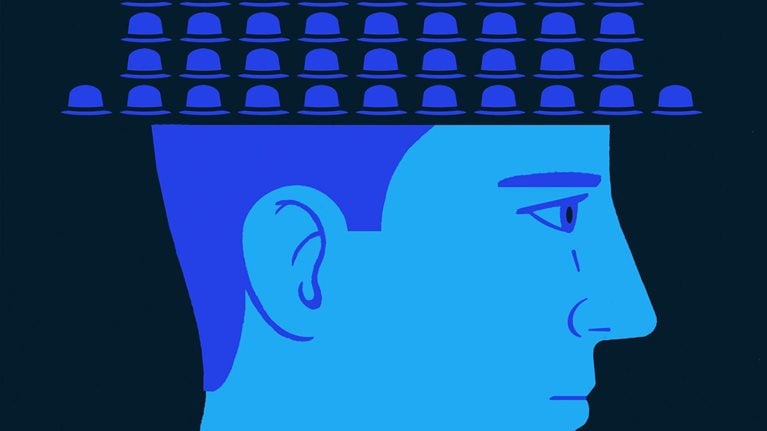
Are we long—or short—on talent?

Redefining the role of the leader in the reskilling era

From research discovery to gap finding
How do you find a research gap?
The aim of all research is to add to or enhance existing knowledge. Arguably, we can only achieve this once we understand the work that has already been carried out in a given field. There are varying opinions, depending on the field of inquiry and methodological approach involved, regarding the level of familiarity a researcher should have with existing literature prior to commencing fieldwork, however it is generally accepted that research should fill gaps in the literature. It is perhaps surprising, then, that so little is written about just how to find a “research gap” in the first place.
Finding the literature
The most obvious way to find a research gap is simply to read and analyse the relevant literature. However, this is easier said than done, as the volume of published literature can be staggering. Fortunately, there are some excellent bibliographic databases, which can speed the process of searching for relevant literature. Literature analysis may then be approached either qualitatively or quantitively.
Qualitative literature analysis
A qualitative analysis may involve the development of a concept matrix (Webster & Watson, 2002) or similar.
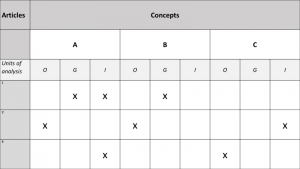
Figure 1: Example of a concept matrix (adapted from Webster & Watson, 2002)
Legend: O (organisation), G (group), I (individual)
The concept matrix assists researchers to organise the literature they have read, according to the concepts it relates to. It can be adapted, depending on the area of interest. In the example above, for instance, units of analysis are included.
Quantitive literature analysis
Quantitative analysis of literature may be carried out using a variety of tools, from systematic reviews to meta-analyses, citation analyses, and text mining (Marrone, 2017). Choice of tools may be determined to some extent by the ability of the researcher to acquire or access the technical expertise to leverage them.
Find the gap, or create one?
Reading and analysing the literature may reveal gaps which can be explored, however Alvesson & Sandberg (2011) suggest that research gaps may also be created by the researcher. By linking together work which has previously been considered separately, a researcher can uncover uncharted territory. In this way, opportunities to contribute to existing knowledge are constructed (Locke & Golden-Biddle, 1997) rather than merely identified.
What does a “research gap” look like?
Several authors have sought to characterise research gaps, describing the various forms they can take, whether considered from the perspective of objectively identifiable existing gaps in research (gap finding) or as opportunities to construct new “gaps” (gap creation). Some examples are summarised below.
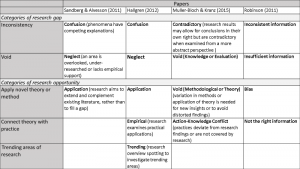
Figure 2: Characteristics of research gaps (Click to see image bigger)
Gap-finding frameworks
Step-by-step guides to finding research gaps are hard to come by, however in the field of medical epidemiology, a framework for identifying research gaps from systematic reviews of literature has been published (Robinson et al., 2011). In this field, the PICOS framework (Population, Intervention, Comparison, Outcome, Setting) is commonly used to characterise a research gap. Robinson et al. (2011) suggest that an analysis of the reason for the existence of the gap can further inform the development of research questions. The reasons elucidated by Robinson et al. (2011) for the existence of research gaps are similar to the characteristics of gaps described by other authors, as shown in figure 2 (Characteristics of Research Gaps).
There are many ways to go about identifying research gaps, perhaps so many that the options may on occasion be overwhelming. A considered approach, coupled with knowledge and utilisation of the tools available to assist in research gap-finding, is likely to result in improved research design.
- Alvesson, M., & Sandberg, J. (2011). Generating research questions through problematization. Academy of Management Review. 36(2), 247-271 [doi:10.5465/AMR.2011.59330882]
- Hallgren, M. (2012) The construction of research questions in project management. International Journal of Project Management, 30(7), 804-816.
- Locke, K., & Golden-Biddle, K. (1997) Constructing opportunities for contribution: Structuring intertextual coherence and “problematizing” in organizational studies. Academy of Management Journal, 40: 1023–1062.
- Muller-Bloch, C. & Kranz, J. (2015) A framework for rigorously identifying research gaps in qualitative literature reviews. International Conference on Information Systems 2015 [available at: https://aisel.aisnet.org/icis2015/proceedings/ResearchMethods/2/]
- Marrone, M., & Hammerle, M. (2017). Relevant Research Areas in IT Service Management: An Examination of Academic and Practitioner Literatures. Communications of the Association for Information Systems, 41, 517-543.
- Robinson, K. A., Saldanha, I. J. & McKoy, N. A. (2011) Development of a framework to identify research gaps from systematic reviews. Journal of Clinical Epidemiology, 64(12), 1325-1330.
- Sandberg, J., & Alvesson, M. 2011. Ways of constructing research questions: Gap-spotting or problematization? Organization, 18: 23–44.
- Webster, J., & Watson, R. T. (2002). Analyzing the past to prepare for the future: Writing a literature review. MIS Quarterly, 26(2), 13-23
Leave a Reply Cancel reply
Your email address will not be published. Required fields are marked *
Save my name, email, and website in this browser for the next time I comment.

Julia Kuzmina
Content Marketing Specialist
julia.kuzmina@valamis.com
August 17, 2022 · updated April 2, 2024
12 minute read
What is a skill gap and how to identify it
While skills gaps have always existed, workforces are currently undergoing dramatic changes that have exposed the shortage of expertise required for the new digital economy.
Therefore, in order to build an effective workforce for the future, organizations need to understand their existing skills gaps.
What is a skill gap?
The importance of analyzing skill gaps in your company, the three types of skills gaps, skills gap vs. performance gap. what is the difference, the challenges of addressing skills gaps, how to identify the skills gap, more practical tips for l&d professionals.
A skills gap is the difference between an employee’s current abilities and the skillset best suited for their job.
Companies have a desired set of skills to perform a given role successfully. This list of skills is dynamic and changes depending on external market forces and internal organizational changes.
Finding employees to match the required skills for every position is challenging; therefore, skills gaps exist.
Many factors can contribute to skill gaps:
- A lack of experience
- Inadequate training
- Poor recruitment
- Employee turnover
- Failures in the broader educational system
- Change in roles or responsibilities
Skills gaps can lead to workplace inefficiency, with staff struggling to handle their responsibilities or perform assigned tasks. In addition, severe skill gaps may lead to employees being unable to perform their roles.
In addition to focusing on an individual’s skills gaps, the concept can also be applied at a company-wide level.
Management can use skill gap assessments when introducing new procedures, technologies or take them into consideration when looking at work culture .
Skills gap analysis is a critical tool for organizations to assess the effectiveness of their workforce. Identifying any skills gaps present and understanding how they limit company performance is becoming essential thanks to new technologies transforming many business sectors.
With new technologies finding widespread use across the business world, the need for skills gap analysis is only growing.
At a time when digitization and automation are redefining what companies need from their employees, skills gap analysis offers the roadmap to a better, more efficient way of working .
Even before the pandemic, the World Economic Forum estimated that half of all employees worldwide need reskilling to learn how to operate in the new technology-powered workplace . Skills gap analysis is the key to successful reskilling and upskilling programs and understanding where workforces need to improve.
Identifying any skills gaps present and understanding how they limit company performance is becoming essential thanks to new technologies transforming many business sectors.
With AI, automation, and other advances, many roles are becoming obsolete, and organizations need to source new skills to match growing technological needs. However, research by McKinsey in 2021 shows 87% of organizations expect to experience skills gaps in the coming years, with 43% saying they already have one.
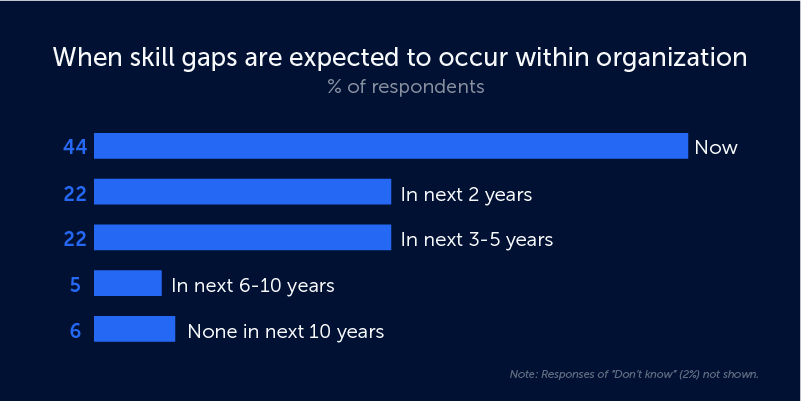
A 2022 survey of CEOs by Deloitte found labor and skills shortages were the 2nd most cited external factor disrupting their business strategy. Also, with the rise of the digital economy, a Salesforce survey found that 76% of global workers don’t feel equipped to operate in new digitally-focused workplaces.
To respond to this gap, organizations must assess their existing workforce and develop active training programs and recruitment strategies to meet the moment.
Benefits of successfully overcoming skills gaps lead to a range of benefits , including:
- Developing a complete understanding of your workforce
- Greater productivity
- Improved agility
- Clear workforce planning strategy
- Competitive advantages over other organizations
Skills gaps can exist in various forms. However, generally speaking, they can be separated into three main types:
- Knowledge Gap – a lack of knowledge related to the job. This could be the specific knowledge required to perform tasks successfully, the knowledge needed to understand how the work fits in the wider organization, or the institutional knowledge particular to a given organization. Removing knowledge gaps can improve employee performance and collaboration between staff members.
- Skills Gap – while knowledge generally refers to learning information and an individual’s intellect, skills refer to the ability to apply the proper knowledge in a given situation. Whereas employees can pick up knowledge through studying, skills must be performed. The skills needed for a particular job could be mental (e.g., coding ability), physical (e.g., fitness required for a physical role), or soft skills such as communication and emotional intelligence .
- Performance Gap – a lack of motivation or engagement leading to poor performance. Unlike the previous two types, performance gaps occur when an employee with all the tools to be successful underachieves. This could be for several reasons, including poor management or individuals being a bad cultural fit for the organization.

How to conduct a skills gap analysis and what to do next
Start building your foundation for strategic workforce development.
The concept of skills gaps can sometimes be confused with performance gaps . While similar, they describe different root causes for underperforming staff members.
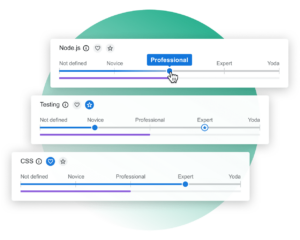
Connecting skills and learning
Valamis provides you with skills management and learning tools in the same platform, allowing you to tailor your content to existing needs.
While many workforces clearly have a problem, addressing skills gaps is challenging. Research from McKinsey found only 33% of capability-building programs always or often achieve the desired results.
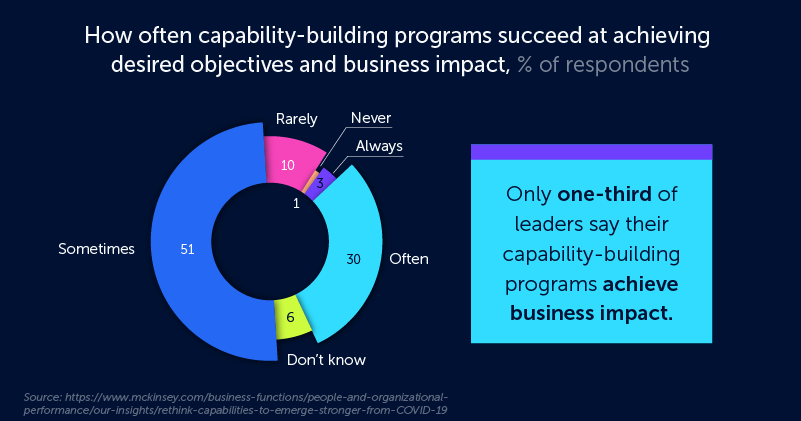
So why is it so hard to overcome workforce skill gaps?
- The same McKinsey research found leadership plays a critical role in the success of skills gap programs ,particularly in setting an example for employees. Surveys found that 65% of respondents believe executives should participate in L&D courses as trainers, facilitators, or learners. Leadership buy-in and modeling the same behavior asked of employees improves success rates when addressing skills gaps.
- Whether through training or hiring, overcoming skills gaps costs money . Many organizations want the benefit of an up-to-date productive workforce but are unwilling to make the investments necessary.
- Similarly, many organizations look to take shortcuts when it comes to addressing skills gaps. For example, McKinsey has developed a lengthy process around planning, developing, and implementing infrastructures to retrain employees post Covid. Their research found organizations that follow every step are 2.5x more successful than those that skip just a single stage.
- When looking to remove a workforce skills gap, it is easy to define the objectives; it is much harder to define the journey. Employees like to learn in different ways, and it can be challenging to implement appropriate formats that cater to everyone’s preferences. Whether it is digital learning, group workshops, expert coaching, or one of many other formats, the best skill gap programs are tailored for each employee.
Identifying this gap is crucial for L&D professionals, as it helps in designing training and development programs that directly address the organization’s needs.
1. Clearly define organizational objectives
Before you can identify a skills gap, you need to understand where the organization is headed.
What are the long-term and short-term goals?
What skills are required to achieve these goals?
Tip: Regularly revisit and revise objectives to reflect changes in the business environment and organizational strategy.
2. Conduct job role analysis
Examine every job role in the organization. Understand its requirements, responsibilities, and the skills necessary for success.
Tip: Involve both upper management and frontline employees in the analysis to ensure a comprehensive understanding of each role.
Check out our latest Skill-based Talent Management article
3. Survey employees and managers
Use questionnaires, feedback forms, or interview sessions to gather insights from employees and their managers about their perceived skills and training needs.
Tip: Utilize anonymous surveys to encourage honest feedback and to ensure that employees feel safe sharing their views.
4. Perform skills assessments
Use online tools (like Valamis ), quizzes, or practical tests to evaluate the current skills of employees. Compare the results against the desired skill levels.
Tip: Rotate the types and formats of assessments to cater to different learning styles and reduce the potential for rote learning.
5. Analyze performance metrics
Review performance reviews, project results, and other relevant data to identify areas where employees are falling short.
Tip: Use data visualization tools to spot patterns and trends over time, enabling a more holistic understanding of skill gaps.
Read our recent blogs to gain more insights on the topic: 10 Valuable Training Metrics to Know and How to Measure and Evaluate Training Effectiveness
6. Competency frameworks
Develop or utilize existing competency frameworks that detail the knowledge, skills, and abilities required for each role.
Tip: Benchmark your frameworks against industry standards and continuously update them as the industry evolves.
7. Feedback from external stakeholders
Sometimes clients, suppliers, or other external partners can provide insights into areas where your employees might be lacking.
Tip: Regularly schedule feedback sessions and establish open channels of communication with these stakeholders.
8. Industry benchmarks
Check industry standards and trends. Are there new tools, technologies, or methodologies that are becoming standard? If so, there might be a skills gap.
Tip: Subscribe to industry newsletters, join relevant professional organizations, and actively engage in forums to stay updated.
9. Skill inventory
Maintain an inventory of current employee skills. This database can help in identifying gaps quickly and can be updated annually or semi-annually.
Tip: Incorporate a digital tool or platform that allows real-time updates and easy access for managers across departments.
10. Focus groups
Organize group discussions among employees to understand their challenges, the skills they feel they lack, and areas where they believe training could benefit them.
Tip: Ensure that focus groups are diverse in terms of department, seniority, and demographic to get a broad perspective.
Ways to fill the gap
There are various ways to fill skills gaps and develop a future-proof workforce. This includes training in the form of:
- Reskilling – training employees to transition to a new role
- Upskilling – adding new skills, so an employee improves at their existing role
- Digital training – focusing on the digital skills needed in the modern workforce
Or new hiring practices based on filling existing skills gaps and recruiting better-skilled staff.
Addressing workforce gaps requires extensive skill gap analysis, the process of determining the difference between what an organization needs from its staff and what it currently receives.
Skill gap analysis requires effective HR processes to accurately reflect the performance of employees and identify the skillsets and knowledge currently lacking or underdeveloped.
Collaborate with HR: Human Resources usually has data on employee performance, turnover rates, and hiring needs. This information can be valuable in identifying skill gaps. Schedule regular sync-up meetings with HR to ensure alignment in objectives and shared data.
Adopt continuous learning: Instead of occasional training sessions, foster a culture of continuous learning. This ensures that skill development is ongoing and adapts to changing needs. Utilize microlearning and just-in-time training modules that employees can access on demand.
Leverage technology: Use Learning Management Systems (LMS) and other e-learning platforms to deliver timely and effective training. Regularly update and refresh the LMS content, ensuring that materials are current, relevant, and engaging.
Advice: Check out Valamis and its Skills Management features
Stay updated: Ensure you’re aware of industry trends and emerging technologies. Regularly attend seminars, workshops, and conferences. Set up Google alerts or other monitoring tools for industry news and updates.
Video: Exploration of the most significant learning and development trends for 2023 by Rob MacAllister, Customer Success Director at Valamis
Customize training programs: Not every employee learns the same way. Offer a mix of training mediums – online courses, workshops, webinars, hands-on training, etc. Use adaptive learning platforms that adjust content based on individual learner’s progress and needs.
Track and measure: Use analytics to measure the effectiveness of training programs. If a program isn’t bridging the skill gap, it might be time to revise it. Incorporate both qualitative and quantitative metrics, and compare them against industry benchmarks when possible.
Seek feedback: After training sessions, seek feedback from participants. This can provide insights into areas that might need further emphasis. Use a mix of feedback tools such as surveys, one-on-one interviews, and digital feedback platforms. Use our Training Evaluation Form .
Pilot programs: Before rolling out a large-scale training program, conduct pilot sessions to gauge its effectiveness and make necessary adjustments. Ensure a diverse group of participants in pilot sessions to gather a wide range of feedback.
External training: Sometimes, the best way to bridge a skills gap is by bringing in external trainers or sending employees for external training programs. Continuously evaluate the effectiveness and relevance of external training providers to ensure quality.
Iterate: The process of identifying and bridging skills gaps is ongoing. Regularly revisit your strategies and make necessary adjustments based on results and feedback. Dedicate a team or individual to monitor the entire process, identify areas of improvement, and ensure that changes are implemented in a timely manner.
By diligently identifying and addressing the skills gap, L&D professionals can ensure that their organizations remain competitive, adaptive, and poised for success in an ever-evolving business landscape.
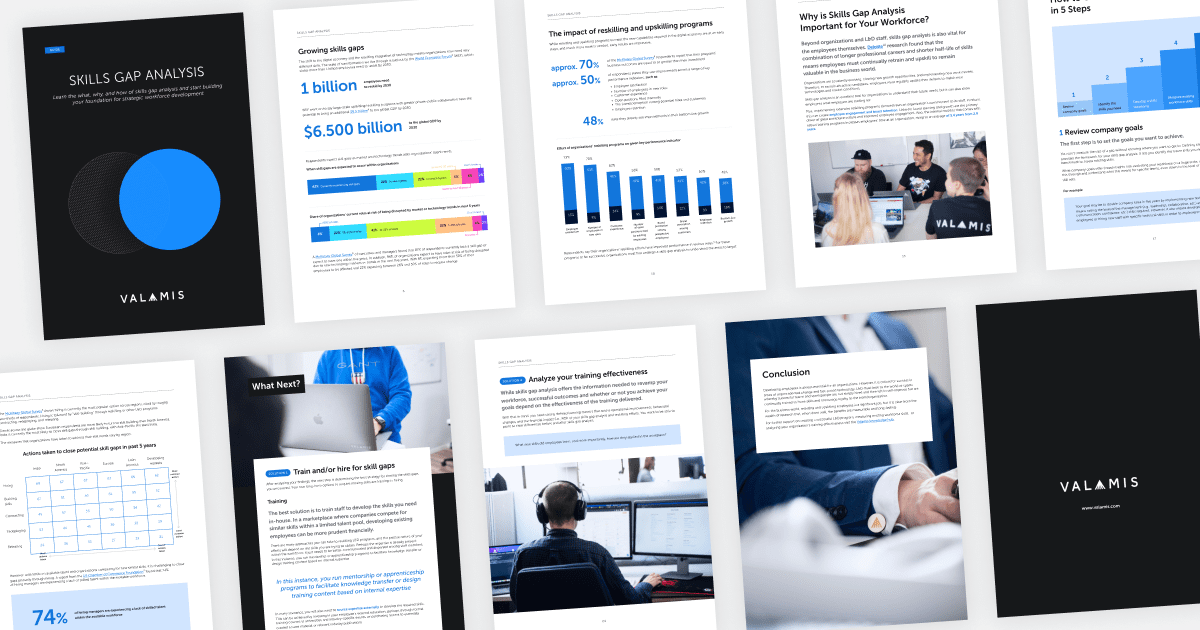
You might be interested in

Enterprise Learning Platform
Discover what an enterprise learning platform is and why you need a new learning solution. Discover the main features every enterprise LMS should have.
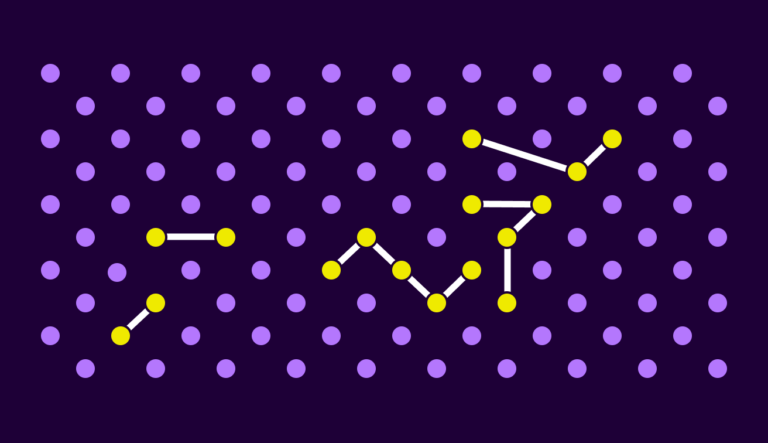
Learning Record Store (LRS)
Learn what Learning Record (LRS) is and what it enables. Discover 4 key steps on how to implement it and how to choose the right vendor.

Skills-based talent management
Discover what a skills-based approach in talent hiring and management is. Learn the key 5 steps on how to implement it in your organization.

Want to create or adapt books like this? Learn more about how Pressbooks supports open publishing practices.
Identifying the gap
Research involves highlighting the questions that remain unanswered in your area of research. This is often referred to as ‘identifying the gap’ in the literature and tells the reader what areas need further investigation in your research area. Identifying ‘the gap’ in your research is fundamental to finding your position in an ongoing conversation by deciding how much you accept, question, or reject the claims that your sources make.
When you start to write about that research, you need to figure out how to signal that position, as you quote, summarize, or paraphrase from your sources.
Read the following text and note the way the researcher identifies the gap in the research as a way of positioning themselves in the research field.

This research project sets out to discover if an experience of Antarctica, specifically mine, could be interpreted through the creation of souvenirs and jewellery. Although Antarctica is considered to be a very remote place it has a long and significant history of science and exploration and most recently has become the destination for tourism [a] . However, unlike most tourist destinations Antarctica has not been memorialised through jewellery and souvenirs in the way of historic tourist locations in the world [b]. Throughout Antarctica’s history explorers have painted images and more recently documented it through photography [c] . Whalers and fishermen have made their own representations of this isolated and uninhabited continent, however, none of these matches the proliferation of souvenirs that have been produced to provide memories and reminders of Europe for example during the times of the Grand Tour or the commonly available souvenirs of popular resorts, sites and locations today [d] .
Excerpt from Kirsten Haydon’s dissertation Antarctic landscapes in the souvenir and jewellery (used with permission)
Check your understanding
Research and Writing Skills for Academic and Graduate Researchers Copyright © 2022 by RMIT University is licensed under a Creative Commons Attribution-NonCommercial 4.0 International License , except where otherwise noted.
Share This Book
- Library databases
- Library website
Library Guide to Capstone Literature Reviews: Find a Research Gap
Find a research gap: tips to get started.
Finding a research gap is not an easy process and there is no one linear path. These tips and suggestions are just examples of possible ways to begin.
In Ph.D. dissertations, students identify a gap in research. In other programs, students identify a gap in practice. The literature review for a gap in practice will show the context of the problem and the current state of the research.
Research gap definition
A research gap exists when:
- a question or problem has not been answered by existing studies/research in the field
- a concept or new idea has not been studied at all
- all the existing literature on a topic is outdated
- a specific population/location/age group etc has not been studied
A research gap should be:
- grounded in the literature
- amenable to scientific study
- Litmus Test for a Doctoral-Level Research Problem (Word) This tool helps students determine if they have identified a doctoral level research problem.
Identify a research gap
To find a gap you must become very familiar with a particular field of study. This will involve a lot of research and reading, because a gap is defined by what does (and does not) surround it.
- Search the research literature and dissertations (search all university dissertations, not just Walden!).
- Understand your topic! Review background information in books and encyclopedias .
- Look for literature reviews, systematic reviews, and meta-analyses.
- Take notes on concepts, themes, and subject terms .
- Look closely at each article's limitations, conclusions, and recommendations for future research.
- Organize, analyze, and repeat!
- Quick Answer: How do I find dissertations on a topic?
Start with broad searches
Use the Library Search (formerly Thoreau) to do a broad search with just one concept at a time . Broad searches give you an idea of the academic conversation surrounding your topic.
- Try the terms you know (keywords) first.
- Look at the Subject Terms (controlled language) to brainstorm terms.
- Subject terms help you understand what terms are most used, and what other terms to try.
- No matter what your topic is, not every researcher will be using the same terms. Keep an eye open for additional ways to describe your topic.
- Guide: Subject Terms & Index Searches: Index Overview
Keep a list of terms
- Create a list of terms
- Example list of terms
This list will be a record of what terms are:
- related to or represent your topic
- synonyms or antonyms
- more or less commonly used
- keywords (natural language) or subject terms (controlled language)
- Synonyms & antonyms (database search skills)
- Turn keywords into subject terms
Term I started with:
culturally aware
Subject terms I discovered:
cultural awareness (SU)
cultural sensitivity (SU)
cultural competence (SU)
Search with different combinations of terms
- Combine search terms list
- Combine search terms table
- Video: Search by Themes
Since a research gap is defined by the absence of research on a topic, you will search for articles on everything that relates to your topic.
- List out all the themes related to your gap.
- Search different combinations of the themes as you discover them (include search by theme video at bottom)
For example, suppose your research gap is on the work-life balance of tenured and tenure-track women in engineering professions. In that case, you might try searching different combinations of concepts, such as:
- women and STEM
- STEM or science or technology or engineering or mathematics
- female engineering professors
- tenure-track women in STEM
- work-life balance and women in STEM
- work-life balance and women professors
- work-life balance and tenure
Topic adapted from one of the award winning Walden dissertations.
- Walden University Award Winning Dissertations
- Gossage, Lily Giang-Tien, "Work-Life Balance of Tenured and Tenure-Track Women Engineering Professors" (2019). Walden Dissertations and Doctoral Studies. 6435.
Break your topic into themes and try combining the terms from different themes in different ways. For example:
Theme 1 and Theme 4
Theme 2 and Theme 1
Theme 3 and Theme 4
Video: Search by Themes (YouTube)
(2 min 40 sec) Recorded April 2014 Transcript
Track where more research is needed
Most research articles will identify where more research is needed. To identify research trends, use the literature review matrix to track where further research is needed.
- Download or create your own Literature Review Matrix (examples in links below).
- Do some general database searches on broad topics.
- Find an article that looks interesting.
- When you read the article, pay attention to the conclusions and limitations sections.
- Use the Literature Review Matrix to track where 'more research is needed' or 'further research needed'. NOTE: you might need to add a column to the template.
- As you fill in the matrix you should see trends where more research is needed.
There is no consistent section in research articles where the authors identify where more research is needed. Pay attention to these sections:
- limitations
- conclusions
- recommendations for future research
- Literature Review Matrix Templates: learn how to keep a record of what you have read
- Literature Review Matrix (Excel) with color coding Sample template for organizing and synthesizing your research
- Previous Page: Scope
- Next Page: Get & Stay Organized
- Office of Student Disability Services
Walden Resources
Departments.
- Academic Residencies
- Academic Skills
- Career Planning and Development
- Customer Care Team
- Field Experience
- Military Services
- Student Success Advising
- Writing Skills
Centers and Offices
- Center for Social Change
- Office of Academic Support and Instructional Services
- Office of Degree Acceleration
- Office of Research and Doctoral Services
- Office of Student Affairs
Student Resources
- Doctoral Writing Assessment
- Form & Style Review
- Quick Answers
- ScholarWorks
- SKIL Courses and Workshops
- Walden Bookstore
- Walden Catalog & Student Handbook
- Student Safety/Title IX
- Legal & Consumer Information
- Website Terms and Conditions
- Cookie Policy
- Accessibility
- Accreditation
- State Authorization
- Net Price Calculator
- Contact Walden
Walden University is a member of Adtalem Global Education, Inc. www.adtalem.com Walden University is certified to operate by SCHEV © 2024 Walden University LLC. All rights reserved.
- Book a Speaker
Lorem ipsum dolor sit amet, consectetur adipiscing elit. Vivamus convallis sem tellus, vitae egestas felis vestibule ut.
Error message details.
Reuse Permissions
Request permission to republish or redistribute SHRM content and materials.
The Skills Gap 2019
An exploratory study on the current state of the skills gap, including what skills employers feel are most lacking, how business are addressing the issue and which remedies have been most effective.
In recent years, there has been a great deal of discussion about the skills gap—the discrepancy between the skills U.S. workers have and the skills required by U.S. businesses to remain globally competitive. Although researchers have worked to understand the existence and nature of such a gap, and although most people—from business leaders to individual contributors—agree that there is a skills gap, little is known about how businesses are addressing the issue, whether those solutions are working and what else needs to be done to prepare for the future of work.
Our research sets out to understand what employers are doing to bridge the skills gap, the effectiveness of those methods, and how industry and job types may play a role. The findings show that employers are making the effort to invest in reskilling workers, to hire from more diverse talent pools and to work with educational institutions to build talent pipelines. However, employers are also reporting that those methods have not been fully effective for their organizations in terms of sourcing, hiring and retaining employees with the skills to do the work.
The skills gap issue is an opportunity for human resource professionals to better understand the skill needs of their organizations and contribute to organizational strategy and success through optimizing planning and understanding how to position their workforce for the future of work.
Read the full report: Skills Gap 2019
Download the infographic

Related Content

Rising Demand for Workforce AI Skills Leads to Calls for Upskilling
As artificial intelligence technology continues to develop, the demand for workers with the ability to work alongside and manage AI systems will increase. This means that workers who are not able to adapt and learn these new skills will be left behind in the job market.

Employers Want New Grads with AI Experience, Knowledge
A vast majority of U.S. professionals say students entering the workforce should have experience using AI and be prepared to use it in the workplace, and they expect higher education to play a critical role in that preparation.
Advertisement

Artificial Intelligence in the Workplace
An organization run by AI is not a futuristic concept. Such technology is already a part of many workplaces and will continue to shape the labor market and HR. Here's how employers and employees can successfully manage generative AI and other AI-powered systems.
HR Daily Newsletter
New, trends and analysis, as well as breaking news alerts, to help HR professionals do their jobs better each business day.
Success title
Success caption
- SUGGESTED TOPICS
- The Magazine
- Newsletters
- Managing Yourself
- Managing Teams
- Work-life Balance
- The Big Idea
- Data & Visuals
- Reading Lists
- Case Selections
- HBR Learning
- Topic Feeds
- Account Settings
- Email Preferences
How to Address a Resume Gap When Switching Careers
- Rebecca Knight

The do’s and don’ts of navigating a career transition that’s taking longer than you hoped.
The prospect of a new career can hold a sense of excitement. But what should you do if your job search has become a disheartening slog and the gap on your resume just seems to be growing wider by the day? What can you do to protect your mental health and rekindle your optimism for the future? In this article, the author offers practical advice to help you navigate your career switch when you’re worried about a widening gap on your resume.
You likely felt a surge of excitement when you made the decision to switch careers . But what should you do if your job hunt starts to become a tedious and disheartening slog — and the gap on your resume is growing wider by the day? How can you address your extended absence from the workforce without making excuses? And how can you stay motivated and resolved in the face of setbacks?
- RK Rebecca Knight is a journalist who writes about all things related to the changing nature of careers and the workplace. Her essays and reported stories have been featured in The Boston Globe, Business Insider, The New York Times, BBC, and The Christian Science Monitor. She was shortlisted as a Reuters Institute Fellow at Oxford University in 2023. Earlier in her career, she spent a decade as an editor and reporter at the Financial Times in New York, London, and Boston.
Partner Center
- Skip to content
- Skip to search
- Skip to footer
Leading Companies Launch Consortium to Address AI's Impact on the Technology Workforce

The Consortium aims to provide actionable insights and identify new opportunities for reskilling and upskilling
News Summary:
- The AI-Enabled ICT Workforce Consortium is led by Cisco and joined by Accenture, Eightfold, Google, IBM, Indeed, Intel, Microsoft and SAP. It will assess AI's impact on technology jobs and identify skills development pathways for the roles most likely to be affected by artificial intelligence.
- The formation of the Consortium is catalyzed by the work of the U.S.-EU Trade and Technology Council Talent for Growth Task Force, Cisco Chair and CEO Chuck Robbins’ participation in the Task Force, and input from the U.S. Department of Commerce.
- Advisors include the American Federation of Labor and Congress of Industrial Organizations, CHAIN5, Communications Workers of America, DIGITALEUROPE, the European Vocational Training Association, Khan Academy, and SMEUnited.
Leuven, Belgium, April 4, 2024 - Cisco (NASDAQ: CSCO) and a group of eight leading companies including Accenture, Eightfold, Google, IBM, Indeed, Intel, Microsoft and SAP as well as six advisors today announced the launch of the AI-Enabled Information and Communication Technology (ICT) Workforce Consortium focused on upskilling and reskilling roles most likely to be impacted by AI. The Consortium is catalyzed by the work of the U.S.-EU Trade and Technology Council’s (TTC) Talent for Growth Task Force, with the goal of exploring AI’s impact on ICT job roles, enabling workers to find and access relevant training programs, and connecting businesses to skilled and job-ready workers.
Working as a private sector collaborative, the Consortium is evaluating how AI is changing the jobs and skills workers need to be successful. The first phase of work will culminate in a report with actionable insights for business leaders and workers. Further details will be shared in the coming months. Findings will be intended to offer practical insights and recommendations to employers that seek ways to reskill and upskill their workers in preparation for AI-enabled environments.
Consortium members represent a cross section of companies innovating on the cutting edge of AI that also understand the current and impending impact of AI on the workforce. Individually, Consortium members have documented opportunities and challenges presented by AI. The collaborative effort enables their organizations to coalesce insights, recommend action plans, and activate findings within their respective broad spheres of influence.
The Consortium’s work is inspired by the TTC’s Talent for Growth Task Force and Cisco Chair and CEO Chuck Robbins’ leadership of its skills training workstream, and input from the U.S. Department of Commerce. The TTC was established in June 2021 by U.S. President Biden, European Commission President von der Leyen, and European Council President Michel to promote U.S. and EU competitiveness and prosperity through cooperation and democratic approaches to trade, technology, and security.
“At the U.S. Department of Commerce, we’re focused on fueling advanced technology and deepening trade and investment relationships with partners and allies around the world. This work is helping us build a strong and competitive economy, propelled by a talented workforce that’s enabling workers to get into the good quality, high-paying, family-sustaining jobs of the future. We recognize that economic security and national security are inextricably linked. That’s why I’m proud to see the efforts of the Talent for Growth Task Force continue with the creation of the AI-Enabled ICT Workforce Consortium,” said U.S. Secretary of Commerce Gina Raimondo. “I am grateful to the consortium members for joining in this effort to confront the new workforce needs that are arising in the wake of AI’s rapid development. This work will help provide unprecedented insight on the specific skill needs for these jobs. I hope that this Consortium is just the beginning, and that the private sector sees this as a call to action to ensure our workforces can reap the benefits of AI.”
“AI is accelerating the pace of change for the global workforce, presenting a powerful opportunity for the private sector to help upskill and reskill workers for the future,” said Francine Katsoudas, Executive Vice President and Chief People, Policy & Purpose Officer, Cisco. “The mission of our newly unveiled AI-Enabled Workforce Consortium is to provide organizations with knowledge about the impact of AI on the workforce and equip workers with relevant skills. We look forward to engaging other stakeholders—including governments, NGOs, and the academic community—as we take this important first step toward ensuring that the AI revolution leaves no one behind.”
The AI-Enabled ICT Workforce Consortium’s efforts address a business critical and growing need for a proficient workforce that is trained in various aspects of AI, including the skills to implement AI applications across business processes. The Consortium will leverage its members and advisors to recommend and amplify reskilling and upskilling training programs that are inclusive and can benefit multiple stakeholders – students, career changers, current IT workers, employers, and educators – in order to skill workers at scale to engage in the AI era.
In its first phase of work, the Consortium will evaluate the impact of AI on 56 ICT job roles and provide training recommendations for impacted jobs. These job roles include 80% of the top 45 ICT job titles garnering the highest volume of job postings for the period February 2023-2024 in the United States and five of the largest European countries by ICT workforce numbers (France, Germany, Italy, Spain, and the Netherlands) according to Indeed Hiring Lab. Collectively, these countries account for a significant segment of the ICT sector, with a combined total of 10 million ICT workers.
Consortium members universally recognize the urgency and importance of their combined efforts with the acceleration of AI in all facets of business and the need to build an inclusive workforce with family-sustaining opportunities. Consortium members commit to developing worker pathways particularly in job sectors that will increasingly integrate artificial intelligence technology. To that end, Consortium members have established forward thinking goals with skills development and training programs to positively impact over 95 million individuals around the world over the next 10 years.
Consortium member goals include:
- Cisco to train 25 million people with cybersecurity and digital skills by 2032.
- IBM to skill 30 million individuals by 2030 in digital skills, including 2 million in AI.
- Intel to empower more than 30 million people with AI skills for current and future jobs by 2030.
- Microsoft to train and certify 10 million people from underserved communities with in-demand digital skills for jobs and livelihood opportunities in the digital economy by 2025.
- SAP to upskill two million people worldwide by 2025.
- Google has recently announced EUR 25 million in funding to support AI training and skills for people across Europe.
“Helping organizations identify skills gaps and train people at speed and scale is a major priority for Accenture, and this consortium brings together an impressive ecosystem of industry partners committed to growing leading-edge technology, data and AI skills within our communities. Reskilling people to work with AI is paramount in every industry. Organizations that invest as much in learning as they do in the technology not only create career pathways, they are well positioned to lead in the market.” - Ellyn Shook, Chief Leadership & Human Resources Officer, Accenture
“The dynamics of work and the very essence of work are evolving at an unprecedented pace. Eightfold examines the most sought-after job roles, delving into the needs for reskilling and upskilling. Through its Talent Intelligence Platform, it empowers business leaders to adapt swiftly to the changing business environment. We take pride in contributing to the creation of a knowledgeable and responsible resource that assists organizations in preparing for the future of work.” - Ashutosh Garg, CEO and Co-Founder, Eightfold AI
“Google believes the opportunities created by technology should truly be available to everyone. We’re proud to join the AI-Enabled Workforce Consortium, which will advance our work to make AI skills training universally accessible. We’re committed to collaborating across sectors to ensure workers of all backgrounds can use AI effectively and develop the skills needed to prepare for future-focused jobs, qualify for new opportunities, and thrive in the economy.” - Lisa Gevelber, Founder, Grow with Google
“IBM is proud to join this timely business-led initiative, which brings together our shared expertise and resources to prepare the workforce for the AI era. Our collective responsibility as industry leaders is to develop trustworthy technologies and help provide workers—from all backgrounds and experience levels—access to opportunities to reskill and upskill as AI adoption changes ways of working and creates new jobs.” - Gian Luigi Cattaneo, Vice President, Human Resources, IBM EMEA
“Indeed’s mission is to help people get jobs. Our research shows that virtually every job posted on Indeed today, from truck driver to physician to software engineer, will face some level of exposure to GenAI-driven change. We look forward to contributing to the Workforce Consortium’s important work. The companies who empower their employees to learn new skills and gain on-the-job experience with evolving AI tools will deepen their bench of experts, boost retention and expand their pool of qualified candidates.” - Hannah Calhoon, Head of AI Innovation at Indeed
“At Intel, our purpose is to create world-changing technology that improves the lives of every person on the planet, and we believe bringing AI everywhere is key for businesses and society to flourish. To do so, we must provide access to AI skills for everyone. Intel is committed to expanding digital readiness by collaborating with 30 countries, empowering 30,000 institutions, and training 30 million people for current and future jobs by 2030. Working alongside industry leaders as part of this AI-enabled ICT workforce consortium will help upskill and reskill the workforce for the digital economy ahead.” – Christy Pambianchi, Executive Vice President and Chief People Officer at Intel Corporation
“As a global leader in AI innovation, Microsoft is proud to join the ICT Workforce Consortium and continue our efforts to shape an inclusive and equitable technology future for all. As a member of the consortium, we will work with industry leaders to share best practices, create accessible learning opportunities, and collaborate with stakeholders to ensure that workers are equipped with the technology skills of tomorrow,” - Amy Pannoni, Vice President and Deputy General Counsel, HR Legal at Microsoft
“SAP is proud to join this effort to help prepare our workforce for the jobs of the future and ensure AI is relevant, reliable, and responsible across businesses and roles. As we navigate the complexities of our ever-evolving world, AI has the potential to reshape industries, revolutionize problem-solving, and unlock unprecedented levels of human potential, enabling us to create a more intelligent, efficient, and inclusive workforce. Over the years, SAP has supported many skills building programs, and we look forward to driving additional learning opportunities, innovation, and positive change as part of the consortium.” - Nicole Helmer, Vice President & Global Head of Development Learning at SAP
About Cisco
Cisco (NASDAQ: CSCO) is the worldwide technology leader that securely connects everything to make anything possible. Our purpose is to power an inclusive future for all by helping our customers reimagine their applications, power hybrid work, secure their enterprise, transform their infrastructure, and meet their sustainability goals. Discover more on The Newsroom and follow us on X at @Cisco .
Cisco and the Cisco logo are trademarks or registered trademarks of Cisco and/or its affiliates in the U.S. and other countries. A listing of Cisco's trademarks can be found at www.cisco.com/go/trademarks. Third-party trademarks mentioned are the property of their respective owners. The use of the word partner does not imply a partnership relationship between Cisco and any other company.
Executive Vice President of the European Commission and Commissioner for Competition Margaret Vestager and US Secretary of Commerce Gina Raimondo join Consortium members in Belgium
Media Contacts
Lauriane giet, anne klingeberger, related content.

Thank you for visiting nature.com. You are using a browser version with limited support for CSS. To obtain the best experience, we recommend you use a more up to date browser (or turn off compatibility mode in Internet Explorer). In the meantime, to ensure continued support, we are displaying the site without styles and JavaScript.
- View all journals
- Explore content
- About the journal
- Publish with us
- Sign up for alerts
- 10 April 2024
How to supercharge cancer-fighting cells: give them stem-cell skills
- Sara Reardon 0
Sara Reardon is a freelance journalist based in Bozeman, Montana.
You can also search for this author in PubMed Google Scholar
A CAR T cell (orange; artificially coloured) attacks a cancer cell (green). Credit: Eye Of Science/Science Photo Library
Bioengineered immune cells have been shown to attack and even cure cancer , but they tend to get exhausted if the fight goes on for a long time. Now, two separate research teams have found a way to rejuvenate these cells: make them more like stem cells .
Both teams found that the bespoke immune cells called CAR T cells gain new vigour if engineered to have high levels of a particular protein. These boosted CAR T cells have gene activity similar to that of stem cells and a renewed ability to fend off cancer . Both papers were published today in Nature 1 , 2 .
The papers “open a new avenue for engineering therapeutic T cells for cancer patients”, says Tuoqi Wu, an immunologist at the University of Texas Southwestern in Dallas who was not involved in the research.
Reviving exhausted cells
CAR T cells are made from the immune cells called T cells, which are isolated from the blood of person who is going to receive treatment for cancer or another disease. The cells are genetically modified to recognize and attack specific proteins — called chimeric antigen receptors (CARs) — on the surface of disease-causing cells and reinfused into the person being treated.
But keeping the cells active for long enough to eliminate cancer has proved challenging, especially in solid tumours such as those of the breast and lung. (CAR T cells have been more effective in treating leukaemia and other blood cancers.) So scientists are searching for better ways to help CAR T cells to multiply more quickly and last longer in the body.

Cutting-edge CAR-T cancer therapy is now made in India — at one-tenth the cost
With this goal in mind, a team led by immunologist Crystal Mackall at Stanford University in California and cell and gene therapy researcher Evan Weber at the University of Pennsylvania in Philadelphia compared samples of CAR T cells used to treat people with leukaemia 1 . In some of the recipients, the cancer had responded well to treatment; in others, it had not.
The researchers analysed the role of cellular proteins that regulate gene activity and serve as master switches in the T cells. They found a set of 41 genes that were more active in the CAR T cells associated with a good response to treatment than in cells associated with a poor response. All 41 genes seemed to be regulated by a master-switch protein called FOXO1.
The researchers then altered CAR T cells to make them produce more FOXO1 than usual. Gene activity in these cells began to look like that of T memory stem cells, which recognize cancer and respond to it quickly.
The researchers then injected the engineered cells into mice with various types of cancer. Extra FOXO1 made the CAR T cells better at reducing both solid tumours and blood cancers. The stem-cell-like cells shrank a mouse’s tumour more completely and lasted longer in the body than did standard CAR T cells.
Master-switch molecule
A separate team led by immunologists Phillip Darcy, Junyun Lai and Paul Beavis at Peter MacCallum Cancer Centre in Melbourne, Australia, reached the same conclusion with different methods 2 . Their team was examining the effect of IL-15, an immune-signalling molecule that is administered alongside CAR T cells in some clinical trials. IL-15 helps to switch T cells to a stem-like state, but the cells can get stuck there instead of maturing to fight cancer.
The team analysed gene activity in CAR T cells and found that IL-15 turned on genes associated with FOXO1. The researchers engineered CAR T cells to produce extra-high levels of FOXO1 and showed that they became more stem-like, but also reached maturity and fought cancer without becoming exhausted. “It’s the ideal situation,” Darcy says.

Stem-cell and genetic therapies make a healthy marriage
The team also found that extra-high levels of FOXO1 improved the CAR T cells’ metabolism, allowing them to last much longer when infused into mice. “We were surprised by the magnitude of the effect,” says Beavis.
Mackall says she was excited to see that FOXO1 worked the same way in mice and humans. “It means this is pretty fundamental,” she says.
Engineering CAR T cells that overexpress FOXO1 might be fairly simple to test in people with cancer, although Mackall says researchers will need to determine which people and types of cancer are most likely to respond well to rejuvenated cells. Darcy says that his team is already speaking to clinical researchers about testing FOXO1 in CAR T cells — trials that could start within two years.
And Weber points to an ongoing clinical trial in which people with leukaemia are receiving CAR T cells genetically engineered to produce unusually high levels of another master-switch protein called c-Jun, which also helps T cells avoid exhaustion. The trial’s results have not been released yet, but Mackall says she suspects the same system could be applied to FOXO1 and that overexpressing both proteins might make the cells even more powerful.
doi: https://doi.org/10.1038/d41586-024-01043-2
Doan, A. et al. Nature https://doi.org/10.1038/s41586-024-07300-8 (2024).
Article Google Scholar
Chan, J. D. et al. Nature https://doi.org/10.1038/s41586-024-07242-1 (2024).
Download references
Reprints and permissions
Related Articles

- Medical research
ROS-dependent S-palmitoylation activates cleaved and intact gasdermin D
Article 10 APR 24

FOXO1 enhances CAR T cell stemness, metabolic fitness and efficacy

Necroptosis blockade prevents lung injury in severe influenza

Biological age surges in survivors of childhood cancer
Research Highlight 11 APR 24

FOXO1 is a master regulator of memory programming in CAR T cells
The PARTNER trial of neoadjuvant olaparib in triple-negative breast cancer
Article 08 APR 24

Blocking cell death limits lung damage and inflammation from influenza
News & Views 10 APR 24

mRNA drug offers hope for treating a devastating childhood disease
News 03 APR 24

Diabetes drug slows development of Parkinson’s disease
Junior Group Leader Position at IMBA - Institute of Molecular Biotechnology
The Institute of Molecular Biotechnology (IMBA) is one of Europe’s leading institutes for basic research in the life sciences. IMBA is located on t...
Austria (AT)
IMBA - Institute of Molecular Biotechnology
Open Rank Faculty, Center for Public Health Genomics
Center for Public Health Genomics & UVA Comprehensive Cancer Center seek 2 tenure-track faculty members in Cancer Precision Medicine/Precision Health.
Charlottesville, Virginia
Center for Public Health Genomics at the University of Virginia
Husbandry Technician I
Memphis, Tennessee
St. Jude Children's Research Hospital (St. Jude)
Lead Researcher – Department of Bone Marrow Transplantation & Cellular Therapy
Researcher in the center for in vivo imaging and therapy.
Sign up for the Nature Briefing newsletter — what matters in science, free to your inbox daily.
Quick links
- Explore articles by subject
- Guide to authors
- Editorial policies

IMAGES
VIDEO
COMMENTS
Step 1: Identify your broad area of interest. The very first step to finding a research gap is to decide on your general area of interest. For example, if you were undertaking a dissertation as part of an MBA degree, you may decide that you're interested in corporate reputation, HR strategy, or leadership styles.
1. The Classic Literature Gap. First up is the classic literature gap. This type of research gap emerges when there's a new concept or phenomenon that hasn't been studied much, or at all. For example, when a social media platform is launched, there's an opportunity to explore its impacts on users, how it could be leveraged for marketing, its impact on society, and so on.
Here are some examples of research gaps that researchers might identify: Theoretical Gap Example: In the field of psychology, there might be a theoretical gap related to the lack of understanding of the relationship between social media use and mental health. Although there is existing research on the topic, there might be a lack of consensus ...
In turn, a "skills gap" has developed in which employers struggle to hire appropriately trained workers. A recent Deloitte report illustrates the breadth of this problem in the context of ...
A research gap is a missing or incomplete piece of information, knowledge, or evidence that limits understanding of a problem, issue, or phenomenon.
Team leaders can use tools such as surveys, quizzes, portfolios, or rubrics to measure the level of research skills in areas such as information literacy, critical thinking, data analysis ...
Identifying a research gap has many potential benefits. 1. Avoid Redundancy in Your Research. Understanding the existing literature helps researchers avoid duplication. This means you can steer clear of topics that have already been extensively studied. This ensures your work is novel and contributes something new to the field.
However, skills gap analyses typically include these basic steps: 1. Identify business goals and objectives. Understanding what your organization aims to achieve is the foundation of a skills gap analysis. Clearly defining your business goals helps align the required skills with the organizational strategy. 2.
As technologies and business models continue their rapid evolution, companies are experiencing a step change in the workforce skills they need to thrive and grow. Previous research has shown that as many as 375 million workers globally might have to change occupations in the next decade to meet companies' needs and that automation could free employees to spend as much as 30 percent of their ...
Critical thinking. Critical thinking refers to a person's ability to think rationally and analyze and interpret information and make connections. This skill is important in research because it allows individuals to better gather and evaluate data and establish significance. Common critical thinking skills include: Open-mindedness.
Finding the literature. The most obvious way to find a research gap is simply to read and analyse the relevant literature. However, this is easier said than done, as the volume of published literature can be staggering. Fortunately, there are some excellent bibliographic databases, which can speed the process of searching for relevant literature.
Though there is no well-defined process to find a gap in existing knowledge, your curiosity, creativity, imagination, and judgment can help you identify it. Here are 6 tips to identify research gaps: 1. Look for inspiration in published literature. Read books and articles on the topics that you like the most.
4 Ways to Bridge the Global Skills Gap. Summary. The global youth employment crisis has implications for social stability and equality that exceed anything we have experienced in our history; 1.3 ...
The skills needed for a particular job could be mental (e.g., coding ability), physical (e.g., fitness required for a physical role), or soft skills such as communication and emotional intelligence. Performance Gap - a lack of motivation or engagement leading to poor performance.
Identifying 'the gap' in your research is fundamental to finding your position in an ongoing conversation by deciding how much you accept, question, or reject the claims that your sources make. When you start to write about that research, you need to figure out how to signal that position, as you quote, summarize, or paraphrase from your ...
Academic research on skills gap-related topics is robust as well, and focuses on several issues. Some research examines the nature and existence of skill misalignments. Other research points to a variety of factors leading to lingering vacancies reported by employers, suggesting that reducing
At its most basic level, the skills gap describes the discrepancy between the skills a particular role requires and the skills employees (and potential employees) have. Discover what the skills gap is and why it matters to ensure your skills remain sharp. Various factors contribute to the formation of the skills gap, such as a lack of qualified ...
Finding a research gap is not an easy process and there is no one linear path. These tips and suggestions are just examples of possible ways to begin. In Ph.D. dissertations, students identify a gap in research. In other programs, students identify a gap in practice.
SHEHU | THE RESEARCH SKILLS LEARNING GAP 45 specifically, there is a gap in the research skills of students who felt unprepared for ENC 1102 and who were struggling in the class. This supports previous research done by Miller and Lambert on the comparison of difference in competencies and skills between high school students,
A research gap develops as a result of the design of the study's constraints, the use of poor tools, or external influences that the study could or could not control. Research needs can be viewed ...
The skills gap issue is an opportunity for human resource professionals to better understand the skill needs of their organizations and contribute to organizational strategy and success through ...
The aim of the research was to carry out a scoping study to examine the evidence associated with various aspects of the current digital skills landscape, focusing on the digital skills gap. We sought to better understand whether and why the digital skills gap is widening, as well as its implications for digital and social inequalities, and what ...
While the notion of a skills gap is a seemingly straightforward concept, below the surface, there are many nuances to the story. This CompTIA research report explores these issues, setting the stage for approaches to tackling the IT skills gap. Key Points. Skills gap has become somewhat of a catch-all term to describe a range of workforce concerns
HBR Learning's online leadership training helps you hone your skills with courses like Career Management. Earn badges to share on LinkedIn and your resume. Access more than 40 courses trusted by ...
Aim/Purpose: This study aimed to evaluate the extant research on data science education (DSE) to identify the existing gaps, opportunities, and challenges, and make recommendations for current and future DSE. Background: There has been an increase in the number of data science programs especially because of the increased appreciation of data as a multidisciplinary strategic resource.
Adapted from " The Gender Gap in Meaningful Work," by Vanessa C. Burbano of Columbia Business School, Olle Folke of Uppsala University, Stephan Meier of Columbia Business School, and Johanna Rickne of the Swedish Institute for Social Research at Stockholm University and Nottingham University. Key Takeaways: Well-being at work is impacted by more than wages alone.
"Helping organizations identify skills gaps and train people at speed and scale is a major priority for Accenture, and this consortium brings together an impressive ecosystem of industry partners committed to growing leading-edge technology, data and AI skills within our communities. ... Our research shows that virtually every job posted on ...
Workforce issues remain a leading concern for manufacturers: A skills gap and an applicant gap. Alongside this potential growth, the 2024 Deloitte and The Manufacturing Institute Talent Study identified another trend: There is not just a skills gap, but notably a gap in applicants for open positions in manufacturing. Three important themes, in ...
The bioengineered immune players called CAR T cells last longer and work better if pumped up with a large dose of a protein that makes them resemble stem cells. The papers "open a new avenue for ...
More research is needed to address the impact of harmful masculinities on sexual and reproductive health and rights (SRHR), according to a new priority research agenda drawing on a global survey of researchers that was published today in The Lancet Global Health. Harmful gender norms affect boys and men in many ways, for example by increasing risky behaviours such as substance use or ...